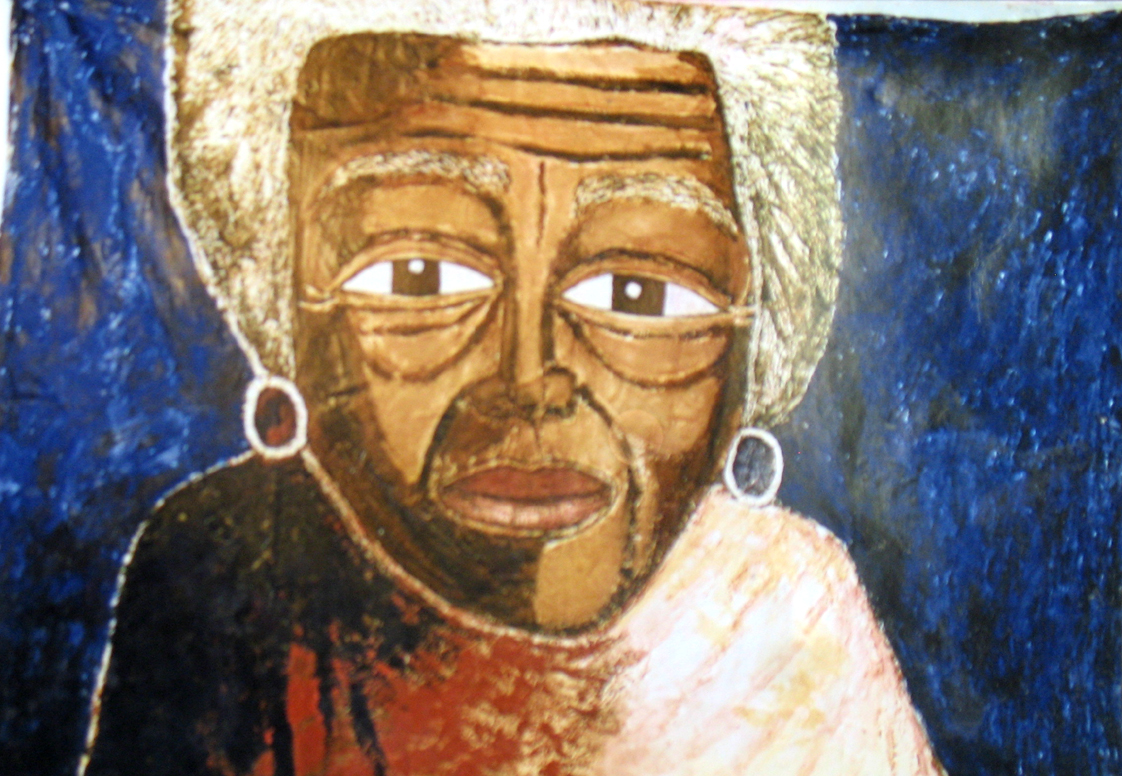
by Terry Messman
[dropcap]O[/dropcap]akland artist Leon Kennedy’s iconic painting of Rosa Parks captures the historic legacy of the civil rights movement by depicting the courageous spirit of one woman who took a stand for an entire people.
Kennedy is a visionary folk artist who lives in Oakland now, but he was born in the South in 1945, 10 years before Rosa Parks was arrested for civil disobedience in Montgomery, Alabama, on December 1, 1955, after refusing to give up her seat on a bus to a white passenger.
“If kids want to know about their history, they need to know about Rosa Parks,” Kennedy said in a recent interview while discussing his imaginative paintings on display at St. Mary’s Center in Oakland. “I was from the South and she’s like a role model to me and to many people. She took a stand for Black people.”
“Now I take a stand in my artwork,” Kennedy added, explaining that his art is a way of honoring the courage and commitment of Rosa Parks and so many others who took a stand for justice and freedom.
One act of resistance can trigger another in a chain reaction, so the initial moment of inspiration is passed from person to person down through the decades. That is why the legacy of the Freedom Movement reverberates to this day, and inspired an artist in Oakland nearly 60 years after Parks took a quiet stand of conscience on a bus in Alabama.
Leon Kennedy’s portrayal of her determined and unconquerable spirit is an artist’s way of passing the legacy of Rosa Parks on to a new generation. “I am learning from people who have gone before me in history and have inspired me,” he said.
Kennedy also painted a huge, mural-sized tribute to African American women from many fields who contributed to American history. The women he profiled are “helping their people get to the Promised Land,” he said. The painting includes actresses Dorothy Dandridge and Cecily Tyson, activists Angela Davis and Rosa Parks, and many others.
“These women dreamed their dreams and their dreams came true,” Kennedy said. His painting was inspired by the book, I Dream a World: Portraits of Black Women Who Changed America.
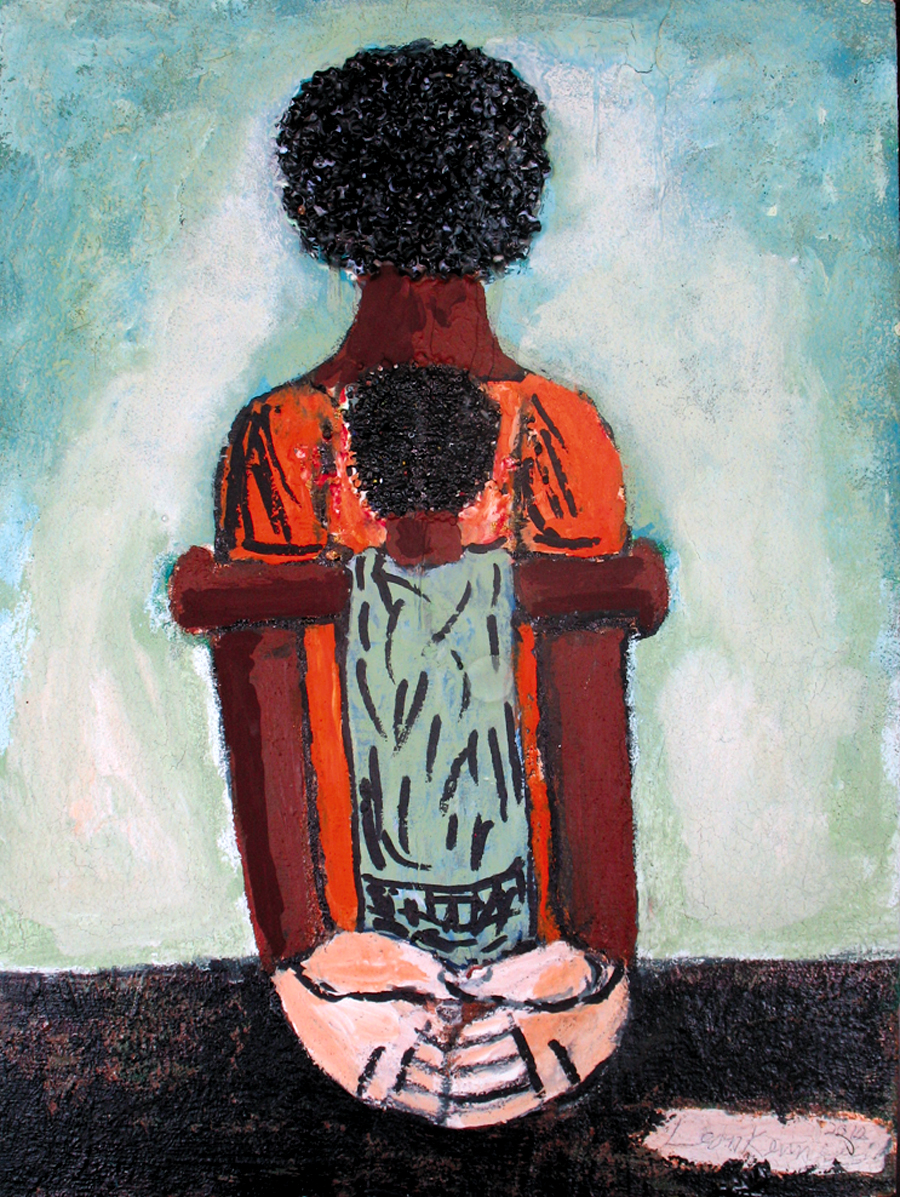
Showing the Beauty of Life
In an interview with Street Spirit, Kennedy said that when he begins to paint a person, he tries to show their beauty. “Life is beautiful and my art is a way to show this beauty,” he explained.
When he creates art, he wants to show people something more than they may be able to see in themselves — something beautiful, something positive in their life.
Art critics refer to Kennedy as a “spiritual visionary artist” and a “modern American master.” His paintings are highly original, with imaginative, eye-catching designs, a beautiful, vivid use of color and a dramatic sense of composition. One critic recently wrote that “Kennedy is a painter’s painter” with a “Van Gogh color sensibility” and “beautiful figuration.”
Above all, Kennedy is a spiritual artist who declares his faith openly and without apology despite the prevalent cynicism of the modern era, and without concession to the secular sophistication of the art world.
“My inspiration and imagination come from God,” he said. “Love is the most important thing in life and the message I show is that God is Love.”
His art is rooted in the deep reservoirs of faith in the African American community, and he explains that his paintings radiate God’s love to others. “My message is the spirit of God and the spirit of the Black community,” he said.
Kennedy said he has been especially inspired and influenced by his minister, Rev. Kevin D. Barnes, pastor of the Abyssinian Baptist Church in Oakland.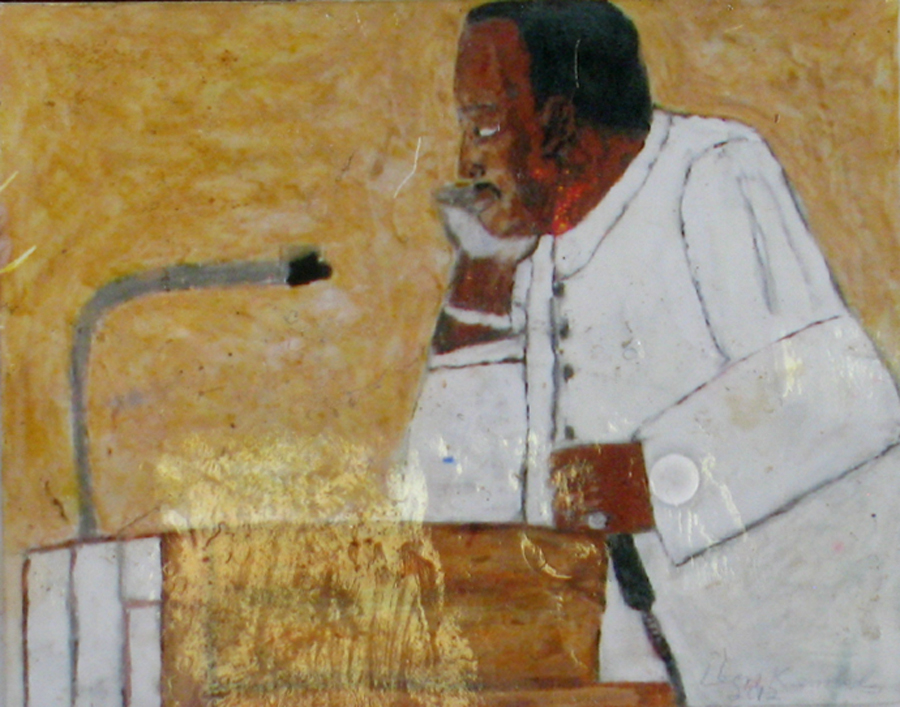
‘Like Going to Church’
Kathy McCarthy, a staff member at St. Mary’s, is so moved by the spiritual message at the heart of Kennedy’s art that she describes it as like going to church.
In an interview, McCarthy said, “I love Leon’s art. It is so spiritual. It is so uplifting. It brings me into the Holy Spirit and the light that we all need to have. And it is so colorful. Because of the intense color and the feeling that you get when you see his art, it’s like going to church.”
Leon Kennedy’s art has been displayed at the Smithsonian Institution in Washington, D.C., the Collection de l’Art Brut in Switzerland, Lowell Revolving Museum, American Visionary Art Museum in Baltimore, African American Museum in Dallas, Redux Gallery in Alameda, and King’s Gallery of the San Francisco Unitarian Universalist Church.
As part of its groundbreaking exhibition of American outsider art, the Smithsonian purchased one of Kennedy’s large, mural-like paintings — a fantastically complex series of several dozen portraits painted on a bed sheet. This masterful work now resides at the Smithsonian American Art Museum.
Kennedy’s art was featured in the book, Contemporary American Folk Art by Chuck and Jan Rosenak. Rosenak wrote, “Leon Kennedy’s paintings — huge mural-like works filled with detailed scenes from black inner-city life — are tapestries taken from his youthful memories of life in a Houston ghetto as well as from what he sees around him in his Oakland neighborhood.”
Even though Kennedy’s paintings have been displayed locally and internationally in art galleries and museums, his brilliant artworks may have found their truest home at St. Mary’s Center in Oakland.
He treasures the many close friendships he has found at St. Mary’s, and, in turn, this community of low-income and homeless seniors cherishes Kennedy’s striking paintings and iconic images as a reflection of their own deeply held values.
Not Only Bread, But Roses Too
St. Mary’s Center not only offers low-income and homeless seniors the support they need to survive economically, but also gives them encouragement and a place to express themselves artistically.
Along with providing shelter, meals, benefits counseling and housing referrals, St. Mary’s staff members help the seniors express themselves in art, music, dance, photography and creative writing. Not only bread, but roses too.
Susan Werner, art facilitator at St. Mary’s Center, has worked with Leon Kennedy for several years, and has seen his artistry constantly grow and flourish.
“Leon is a humble, soft-spoken man who lives passionately and purposefully as an artist,” Werner said. “When he shows his art, he speaks of God’s love for all people and the blessing of fellowship.”
Kennedy has indeed found fellowship at St. Mary’s, where he is part of a community that appreciates his art. One of his works, “Fellowship With One Another,” is an iconic image of communion with 15 people gathered around a table, sharing a meal together. Kennedy has painted their table fellowship in the form of a circle, a mandala, a symbol of unity in community.
‘Everyone has their own beauty’
Community is a central part of Kennedy’s vision of life, as shown in his painting, “Thou Shalt Love Thy Neighbor as Thyself.” Kennedy explains that his art stems from his love for humanity, and he especially loves to paint the faces of the people that matter most to him, his close friends and family and neighbors.
“I love to see a picture of the beauty of old faces, young faces, all colors,” he said. “Everyone has their own beauty, everyone has character, and everyone goes through something.”
Susan Werner has seen the artist’s growing focus on creating art that expresses love for one another. “Leon’s always been using real life and real people and our connection to one another as his theme,” Werner said. “Originally, some of the images were very focused on that direct connection with God and praising God and worshipping together. What I’ve seen him focus on lately is his understanding of ‘Love One Another.’ So now there’s a lot more images about love and relationships between people. It’s very important for Leon to show through his art that people need each other.”
At first glance, Kennedy’s painting, “Love Thy Neighbor,” is a fairly straightforward portrait of the faces of his friends, his Oakland neighbors, and his community members at St. Mary’s Center.
A second look reveals something startling and surreal and even disorienting. In the dreamlike perspective of Kennedy’s painting, the laws of time and space — and even mortality — are suspended, so his real-life neighbors co-exist simultaneously with long-departed elders and historical figures such as Nelson Mandela.
The artist’s present-day friends at St. Mary’s Center are magically juxtaposed with Dr. Martin Luther King — who died 46 years ago — and with Kennedy’s own mother, Ella Mae Kennedy — dearly loved but no longer among the living.

The art of resurrection
It is a stunning effect, the casual, matter-of-fact way in which Kennedy’s living friends are portrayed right next to long-gone elders and assassinated civil rights leaders — and no one seems at all surprised by the miracle of resurrection in their midst.
In Leon’s vision, even death does not shatter the bonds of love and community. It’s nothing less than an announcement of resurrection from an artist whose faith is so interwoven with his life that he never doubts for a second the soul’s ongoing life after death.
At the heart of Kennedy’s artistry is his belief that love is the living connection between all of us. That is why he has chosen to paint the people he loves and cherishes. And that is why the painting is entitled, “Thou Shalt Love Thy Neighbor as Thyself.”
His artwork is more than a series of faces. It is an exhortation to love one another, and to cherish the lives of our friends and families and neighbors. His painting is a reminder that love for others is the most important spiritual value of all.
Kennedy said, “We all are family. We connect to each other. My work is based on community and family, and I love doing the faces and showing the heart and love. The heart of the community — you call it love. I have God’s love and God’s spirit and passion for people. Each person is an expression of God within. Each one is blessed in different ways.”
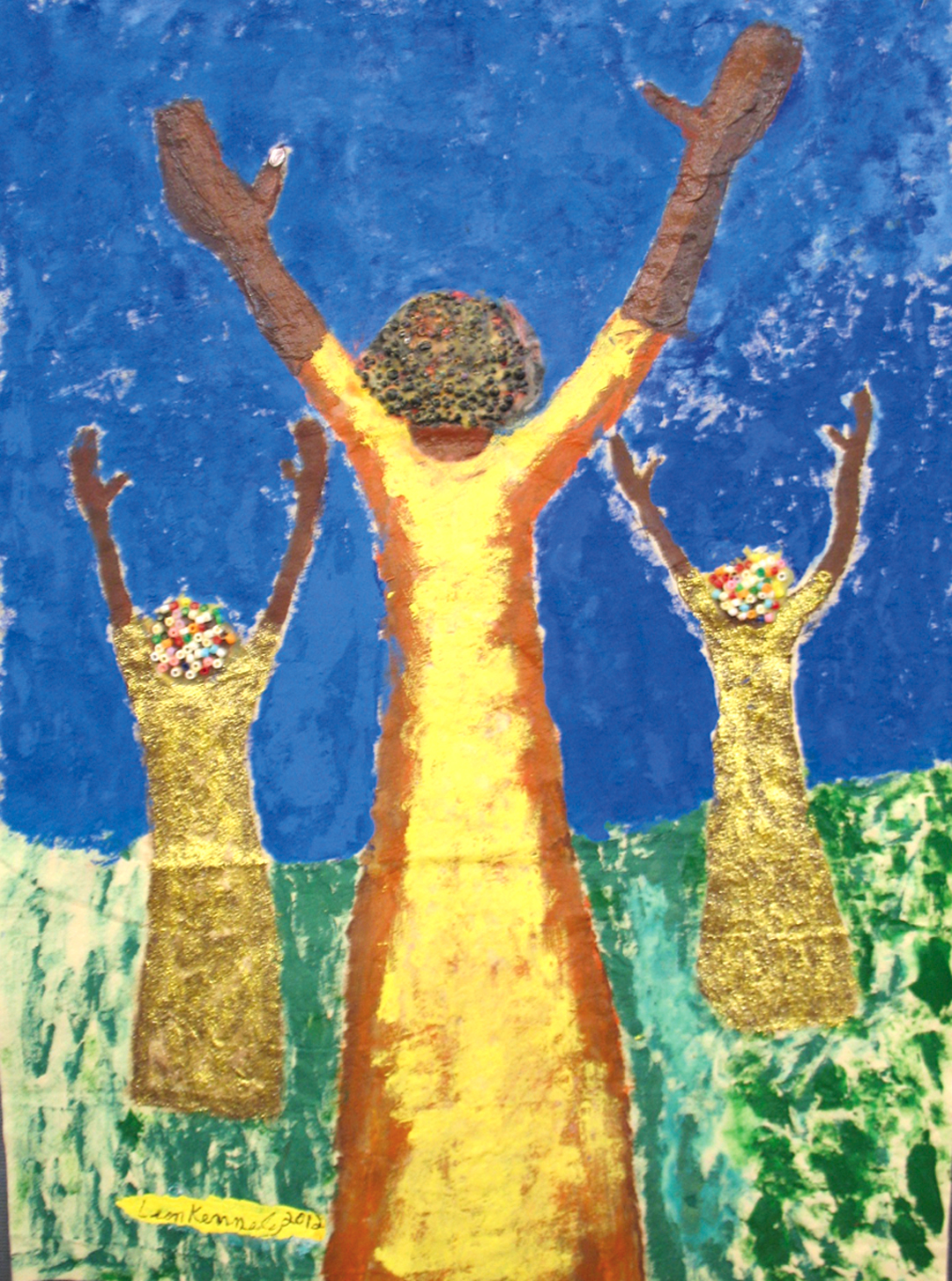
Kennedy’s art has been especially important in giving the blessing of beauty and hope to many of the homeless members of St. Mary’s community who have endured a great deal of personal hardships and suffering while living on the street. Kennedy’s art tells them that they are not alone in their pain and sorrow.
St. Mary’s staff member Kathy McCarthy said, “We’re all so isolated and separated, and need to remember we all feel the same pain, have the same sorrows, and the same joys. We are part of each other and we are each other.”
Art and beauty and love and friendship are no less important than food and shelter in welcoming people “who come to St. Mary’s Center impacted by harsh circumstances,” according to McCarthy. It enables people who have endured the hostility and dangers of the streets to “see the beauty, light and presence of something greater than all of us,” she said.

Serving one another
It is profoundly important for Leon Kennedy that his art serves the community. His greatest mission as an artist is to express the love for one another that is at the very heart of all religion.
“The main idea of my art is concern for people, encouraging someone else,” he said. “I love when someone loves the work, and feels touched. We’re here to serve and love and encourage one another. When I get a vision, I hope it helps someone.”
Living on the streets of Oakland can be difficult and frightening. Many are driven to despair by the constant hardships and cruelty they face. Many feel abandoned by everyone, and give up on the hope of ever again finding love and a better life.
Kennedy sees his art as an attempt to bring love and faith to those who feel broken and lost. He constantly works to create art that may give new hope to people living only a step or two away from despair and poverty.
He has been greatly influenced by his minister, Pastor Kevin Barnes. “I learn so much listening to my pastor,” Kennedy said. “He encourages people to make a difference in other people’s lives. He says to share one’s talents to help someone. He and I would agree we’re here to make the world a better place to live.”
His art is for everyone
Leon’s art is meant to encourage homeless people forced to live on the streets. His art is for African Americans who have overcome oppression and poverty, and have found lasting hope in their community’s historic struggle for justice. His art is for everyone.
“My work deals with the endless struggle and the Black man’s fight to be free,” he said. “Today, my work is more spiritual than political. It conveys love and unity. I try to reach the truth and light that is within each of us.”
Leon strongly emphasizes that his vision of community is inclusive. His artwork, “Love Thy Neighbor,” portrays the multiracial diversity of Oakland. His African American family and friends, his white friends and his Chinese neighbor from down the block are all joined together as one on the canvas of Kennedy’s visionary imagination.
“Every day I know what I am going to do,” Kennedy said. “I’m going to inspire somebody. I have a positive attitude. Love is at the center. My ideas come from God. Like Martin Luther King, I focus on being with God and doing his will. All my art is from God. I go within, and the gift comes from God. I am a servant of God and hope to be a blessing for whomever I contact.”
Finding his calling
“As a child I knew that art was my vocation,” Kennedy said. He was born in 1945 in Houston, Texas, and moved to the Bay Area in 1965. “I paint memories of my inner-city life in Houston as a youth and of urban scenes in Oakland where I currently live.”
His art reveals his spirituality and his gratitude for his blessings. “My work is an affirmation of faith, love and charity in my life,” he said. “That is what we need most in our community. Love is most important in life and the message I show is that God is Love.”
In Oakland, the folk artist began by painting on cloth, but he soon ran out of canvas, so he started painting on bed sheets and other found materials.
It seems fitting that he often finds his “canvases” on the street. “My art studio is the street,” Kennedy explained. “I paint on bed sheets that I hang on wooden fences and building walls.”
Today, Kennedy uses a variety of materials for a canvas: bed sheets he has found on the streets, pieces of cloth, canvas, wooden boards, even tables and chairs. Many of the materials he works with come from the East Bay Depot for Creative Reuse in Oakland. He creates his artworks with markers, paints, crayons, beads, glitter, cotton, yarn and rope.
At times, Kennedy’s use of recycled materials and found objects from the streets seems deeply symbolic.
In describing his painting, “Fellowship with One Another,” Carol Johnson and Catherine Fisher of St. Mary’s Center wrote, “Leon Kennedy paints on bed sheets to remind us of those without them. Aware of how it feels to be alone, his journey and artistic talent depicts the power of realizing we matter. He captures what we believe — our humanity is wrapped up in each other.”
Kennedy paints nearly every day, often working on a bed sheet or a huge piece of cloth spread out on the floor of his studio apartment. He paints while kneeling, as if immersed in prayer. He explains that artistic visions constantly come to him.
Destiny in God’s Hands
His art often focuses on the eyes and hands. He describes the eyes as the windows of the soul. And many of his paintings show hands lifted up in prayer or reaching out to touch the hands of others.
“The hands are my trademark,” he said. “In church, the hands are raised in worship and praise. People take their hands for granted, but they use their hands a lot. If I didn’t have my hands, I couldn’t do my artwork. Your hands and your imagination work together. If you just had imagination with no hands, you could not express yourself through art.”
One of his uniquely imaginative paintings, “Destiny in God’s Hands,” shows multitudes of hands — a forest of arms — uplifted in prayer and praise.
Because of his beautiful sense of composition, the painting is very compelling, and it conveys the artist’s belief that our destiny, our life, and all our possibilities are in God’s hands.
Dramatic image of faith
Kennedy created the painting, “Trust God,” as an illustration of a scriptural passage that is very important in his life: “Trust in the Lord with all thine heart.”
This seemingly simple figure of a solitary woman with uplifted arms holding a staff has an almost indescribable power and grace. In this dramatic image of faith, the woman lifts her arms up to the blue heavens, and almost seems to be lifting up the sun. Her yellow hat is so brightly colored, it seems like she herself is the sunrise.
Her staff is reminiscent of Psalm 23: “Even though I walk through the valley of the shadow of death, I fear no evil, for you are with me. Your rod and your staff they comfort me.”
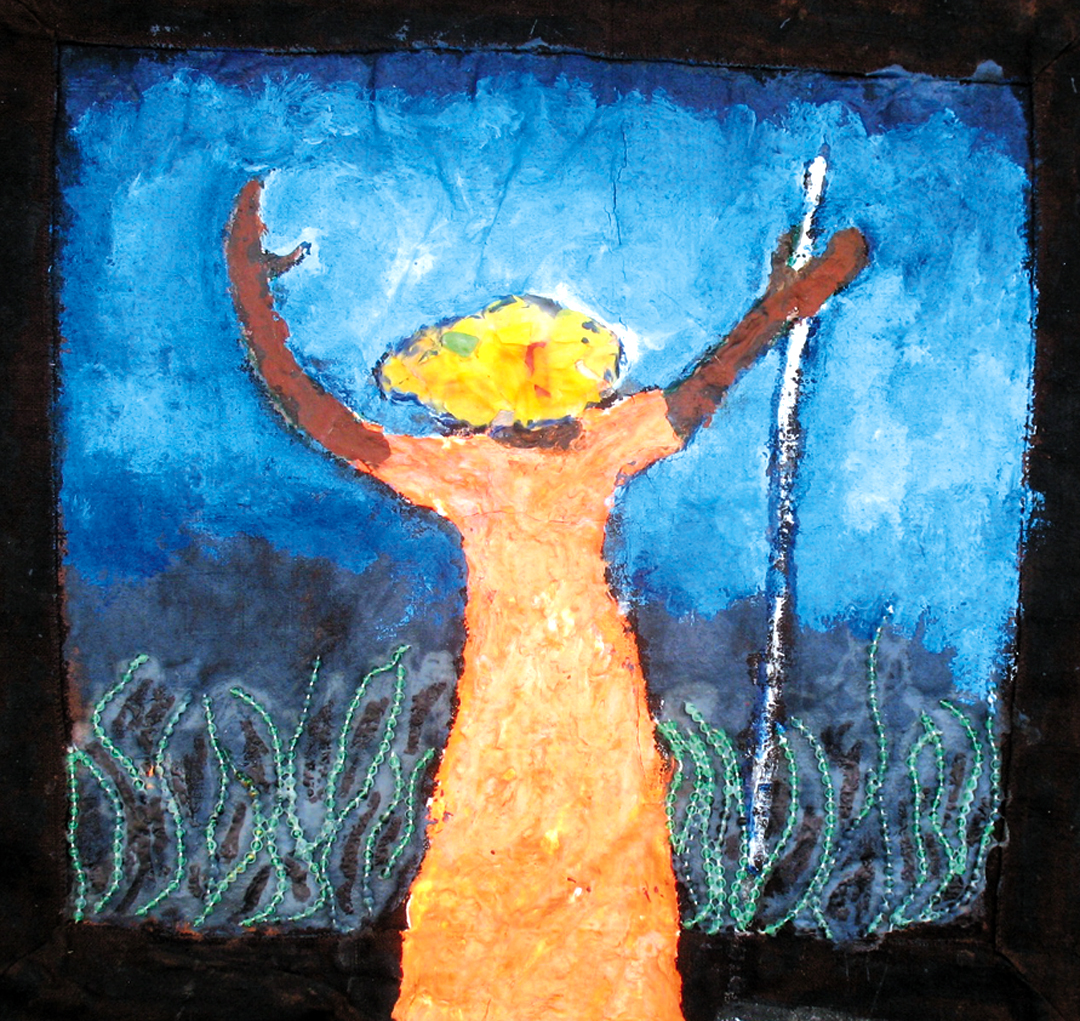
Praise
The artwork entitled “Praise” was created with acrylic paints on a piece of black cloth Kennedy found on the ground. This work is meant to show how “people are all together, united, joined at the moment of praise.”
At first glance, the painting seems to depict yellow and red candles or flames but a closer look reveals that the “flames” are actually human figures with their arms uplifted in praise.
The people look like “the consuming fire of the Holy Spirit,” Kennedy said. He was envisioning the burning bush that Moses could approach only after taking off his shoes because he was on holy ground. Praise and spiritual fire. “It symbolizes being blessed,” Kennedy said.
From Our Heart
In this bright-red vision, two women with heads bowed clasp each other’s hands. They create a heart-shaped outline as they join together in giving thanks.
The artist created this compelling image to illustrate his belief: “When we gather in God’s name, God is present. In everything, give thanks from our heart.”
While looking at this work, Kennedy said, “This art is my calling. It is my life. God gave me this gift to make spiritual art and this love of drawing people.”
God don’t move my mountain
A familiar spiritual has these thought-provoking lyrics: “Lord don’t move my mountain, but give me the strength to climb.”
Rather than asking that life’s trials and hardships be removed, Leon’s painting joins the spiritual song in asking for the strength to climb his own mountain. This visionary painting is one of Kennedy’s most beautiful works of art.
“The vision of this image of two men facing one another, in prayer, hands connected, just came to me,” Kennedy said. “After I painted this, I heard a woman at my church sing the old spiritual song, ‘God Don’t Move My Mountain.’ This song is testimony to my own life, it feeds my spirit. I knew ‘God Don’t Move My Mountain’ was the meaning of these men robed in orange and yellow and people standing in praise and prayer. All the people are giving God the glory.”
The eye between the two men symbolizes God watching over our life, always present, Kennedy explained.
“In my own life, I know struggle, and I know strength through God,” he said. “The mountain is life, and I climb in prayer, anytime and anywhere. I pray through good times and trials and tribulations. When I feel low, I think about how good God is, and I feel love and thank him.”
*********************
Leon Kennedy’s art is available for display and sale, at private homes and galleries. Contact Susan Werner, art facilitator at St. Mary’s Center, for information about exhibiting and commissioning Leon’s art. swerner@stmaryscenter.org, 510-923-9600 ext. 231.
